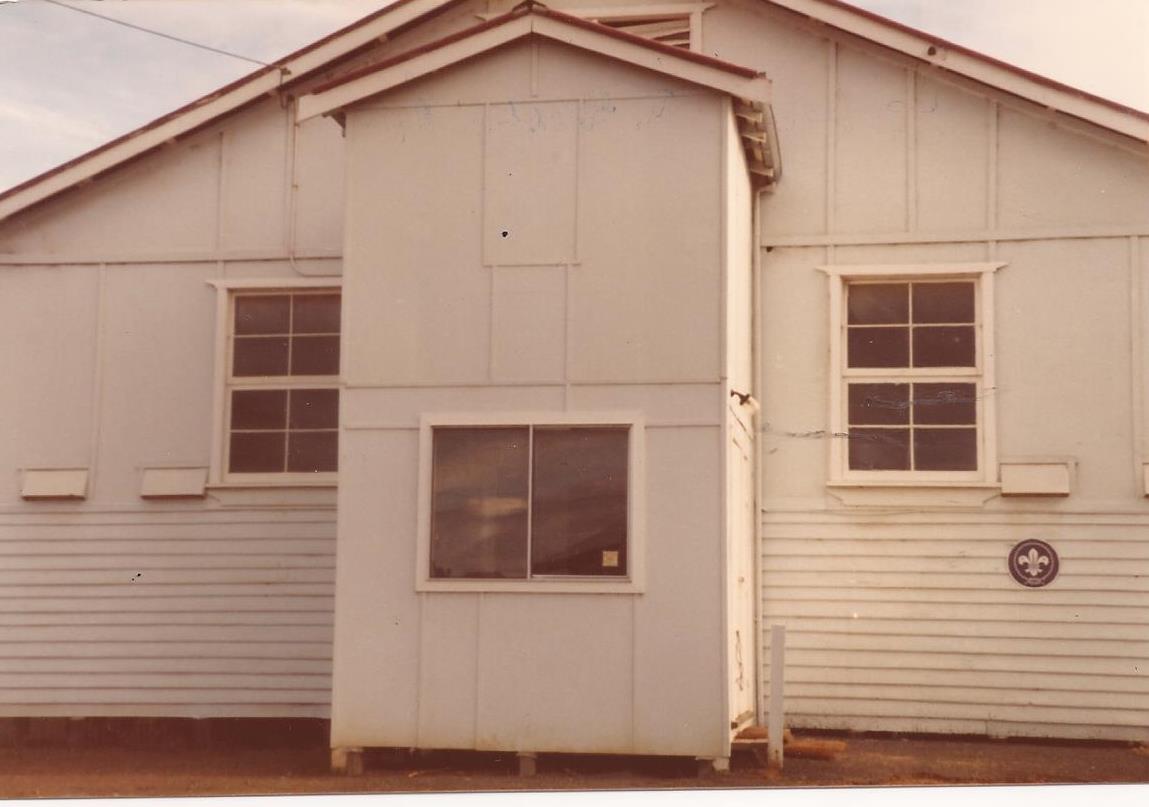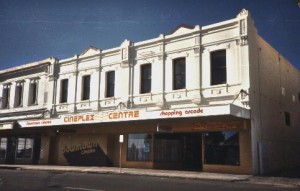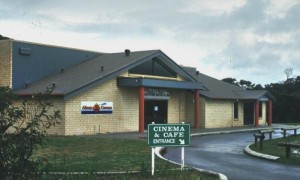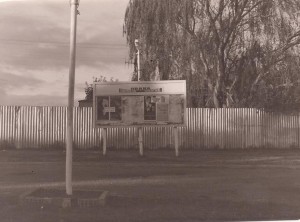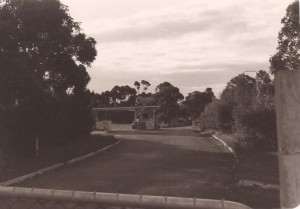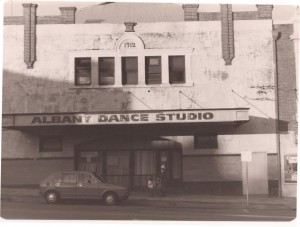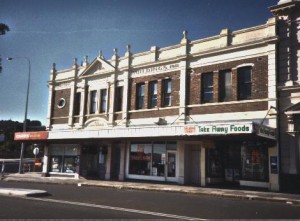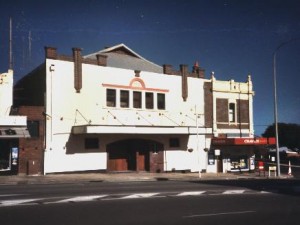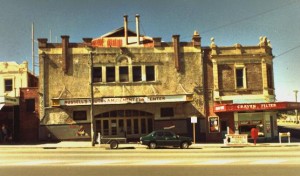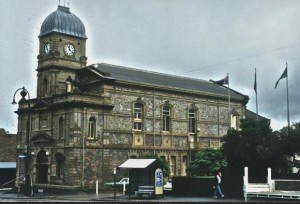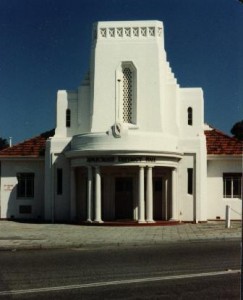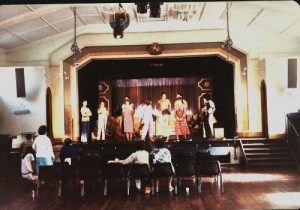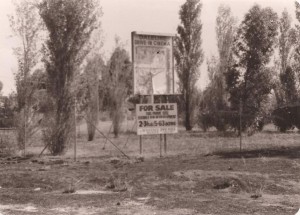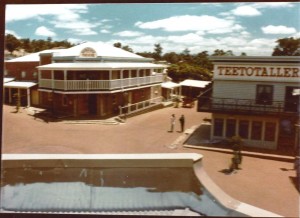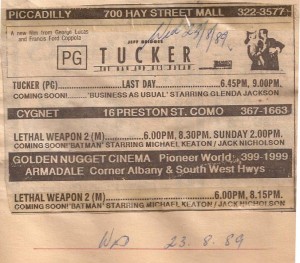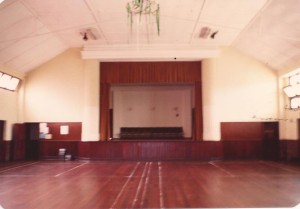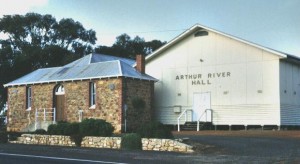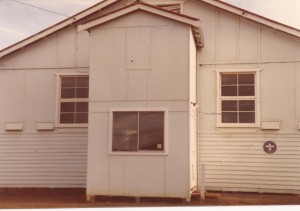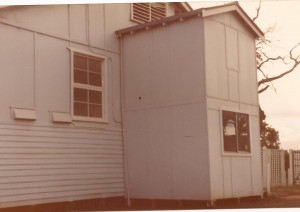Quicklinks
| Agnew | Albany | Applecross |
| Arrino | Arthur River | Augusta |
AGNEW
AGNEW PICTURE GARDENS
Beryl Demasson remembers that before the war Alf Peterson screened at Agnew, in an open air venue beside the hotel. Once a week, cars would drive in and face the screen, with sound broadcast from loudspeakers. These screenings were being presented at least in 1938 and may have started as early as 1935, but they stopped when Alf enlisted. When he returned from the war in 1946, he tried to start up again, and is listed in the 1947 Post Office Directory and the 1948/9 Film Weekly as exhibitor at Agnew Gardens. But the venture was not so successful this time, and he moved on to Leonora and Laverton and other nearby townships.
Sources: Film Weekly Directory 1940/41, 1948/9, Post Office Directory 1947
Interview (Ina Bertrand): Beryl Demasson (1999)
Photo: 1 exterior, b&w, n.d. (1938?), Beryl Demasson
ALBANY
BORONIA DRIVE-IN ,Troode St, Albany
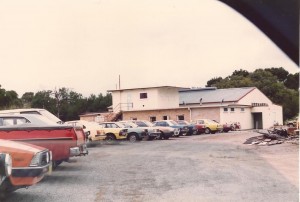
Boronia Gardens Albany 1988This drive-in was located on the western side of Troode St, Collingwood Park, opposite the intersection with Wright St. It was built by Albany Theatres to counter the third drive-in announced for Albany – the Central 70. It was operated by Phil Smith who also operated the Orana. Once the Boronia was opened in January 1964, screenings ceased in the Middleton Beach Hall. The last advertisement for the Boronia was on 22 March 1967, only three years after it opened.The site was purchased by the Christian Family Church, and in 1997 nothing was left of the drive-in.
Sources: Film Weekly Directory 1965/6 – 1966/7
Public Health Department, building permit, Battye 1459
Max Bell, Perth – a cinema history, The Book Guild, Lewes,Sussex, 1986, p.131
Albany Advertiser , 1964 – 1965
Daily News 7 February 1968
Interviews (Colleen Pead): Ron Crisp (1986), Ron Woods (1986)
Photos: exterior, 1988, Roy Mudge
CENTRAL 70 DRIVE-IN Barker Rd, Albany

Central 70 Albany 1988This drive-in opened on 26 December 1964, on the western side of Barker St, opposite the intersection with Stead Rd. It was called the Central 70 because it was the most centrally located of the three drive-ins in the town and the only one to have 70mm projection facilities. It was built for Albany Investments Pty Ltd, a local syndicate with R. W. Wood as secretary, Lindsay Day and Fred (or Syd?) Moore as directors, and Ron Crisp as manager of the cinema. Dorsets later bought out Day, Moore and Woods, and by 1981 Albany Investments was run by John Barnsby. It had provision for 480 cars and 180 seated patrons. In 1982 Orana Holdings took over the Central 70 lease, and ran it from 7 October 1982 to 10 February 1983, when the Siemiginowski family bought Orana Holdings, including the Central 70 lease, and immediately closed the Central 70. They held the lease for only a few weeks before the land was sold, and subdivided for an industrial estate. City Theatres bought the Central 70 equipment and Alan Crew installed it in the Beechline.
Sources: Film Weekly Directory 1965/6 – 1971
Public Health Department, building permit, Battye 1459
Max Bell, Perth – a cinema history, The Book Guild, Lewes, Sussex, 1986, p.132
Albany Advertiser, 1964 – 1965
Interviews (Colleen Pead): Ron Crisp (1986), Ron Woods (1986)
Interview (Ina Bertrand): Alan Crew (1997)
Informant: Ron Siemiginowski (1997)
CREMORNE GARDENS Stirling Tce, Albany
The Royal George Hotel was built on the north side of upper Stirling Terrace between York St and Spencer St. On 28 November 1896, the Cremorne Gardens opened behind the hotel, with Edward Reynolds registered as proprietor and W. B. Warner as lessee. The venue had been the yard of the hotel, and the local newspaper reporter was impressed with the transformation:
Entering under the archway from Stirling-terrace, visitors pass up a gravelled walk festooned with Chinese lanterns, illuminated with numerous gas-jets, and bordered with flower beds. Passing the entrance door, the full effect of the improvements is at once seen. In the background is a convenient stage, with scenery, wings, festoons of drapery, and flags. The side walls are cleverly painted by Mr H.Tassell, who has depicted mountains, lakes, thick bush and partial clearings, winding rivers and stately gullies, in a decidedly effective manner. The middle of the gardens has a fountain, whose falling waters give refreshing suggestions to eye and ear. In one corner stands a cleverly-arranged piece of rockery. Flower beds and borders have been filled with pot plants in bloom, including fragrant musk, gaudy phloxes, carnations, pansies, chrysanthemums, dahlias, lilies, ferns, and native plants. These in a short time will be thoroughly established, and even at present relieve the newly formed parterres from nakedness. Long branches of bright borganvillia (sic), pendant from fountain and vases, look decidedly handsome as floral decorations, and the full-leaved almond tree in one corner fits in with the new surroundings admirably, and supplies a welcome shade for occupants of rustic seats. The entire area has been turfed, and at necessary places neat gravelled walks bisect the lawn. [At night]… Fairy lamps, Chinese lanterns, and brilliant gas jets in fancy globes have, by Mr A. Reeve’s mechanical skill, been placed in advantageous places, and shed sufficient light for comfort and effect. (Albany Advertiser, 1 December 1896)
It was a live venue, with various entertainments available in the gardens setting, and a section for theatrical performances which was part-roofed in 1897 to allow the season to extend.On 11 January 1906 the Theatre Gardens re-opened after a long break, under the direction of Gerald Shaw. From February 1906, travelling film exhibitors screened there occasionally, for instance the Great American Vitascope Co from 10-17 February 1906, and the Ada Delroy Co with the London Bioscope in April that year. These screenings were conducted in competition with others at the Town Hall and the Princess Pavilion. The Cremorne Gardens was damaged by fire in 1910 and never returned to use as a motion picture venue.
Sources: Max Bell, Perth – a cinema history, The Book Guild, Lewes, Sussex, 1986, p.105
Donald S.Garden, Albany: a panorama of the sound from 1
DOWNTOWN CINEMA, 96 Stirling Tce, Albany
On 9 January 1980, when the only remaining film venue in the town was the Orana drive-in, a new hardtop cinema appeared – the Downtown Cinema, built inside a shopping arcade in Stirling Tce (now Proudlove Ave) and with only 200 seats. By 1982 the lease was owned by Orana Holdings, and so was sold to the Siemiginowski family when they bought Orana Holdings. They operated the Downtown till November 1987, when they transferred to Cinema One in the Town Hall.In 1997, the building was Stirling Terrace Arcade, containing shops and a restaurant.
Sources: Informants: Ron Siemiginowski (1997), Ron Woods (1986)
Photos: 1 exterior, 1981, colour, Bill Turner
1 exterior, 1985, colour, Robert Newton
MIDDLETON BEACH TEA ROOMS, Middleton Beach, Albany
Edgar Green owned Greens Hall in the v formed by the intersection of Marine Drive and Adelaide Cres, Middleton Beach. In the fifties, 16mm films were screened in Greens Hall six nights a week by Ron Crisp, but screenings ceased when the Orana Drive-in was opened. In 1997, Greens Hall was used as the Beachside Restaurant.
Sources: Interviews (Colleen Pead): Ron Crisp (1986), Ron Woods (1986)
Interview (Ina Bertrand): Len Lambert (1997)
ORANA DRIVE-IN Albany Hwy, Albany/ ALBANY TWO/ ALBANY THREE
During 1959, Albany Pictures (which was already operating the two hardtops in the town – the Empire and the Regent) began to investigate the possibility of building a drive-in. But another company (R.S.Couper and Associates) was similarly interested, so the two companies combined into Albany Drive-in Cinemas Ltd and built the Orana, the first of Albany’s three drive-ins, on land already acquired by Coupers. It opened, on the western side of the highway, opposite the intersection with Anson St, on 12 April 1960, with provision for 374 cars:
Built on a steeply-sloping site on the outskirts of the town, the drive-in has a dual road system serving the 10 ramps and a 70 by 40 foot screen. (Film Weekly 31 March 1960 p.9)
It was managed by Phil Smith, and when Kanzlers wished to sell in 1972 Smith set up Orana Holdings with other shareholders and bought out the Kanzlers’ business, which included the freehold of the Orana and the lease on the Downtown. Orana Holdings continued to run the Orana, including installing Cine-Fi sound in November 1978. Then in 1982, after protracted negotiations which included Orana Holdings taking over the lease of the Central 70, the Siemiginowski family bought Orana Holdings. They continued to run the Orana, in conjunction with the screenings at the Downtown Cinema or Cinema One in the Town Hall, but by then the effects of television and later video were eating into drive-in business, and the screenings at the Town Hall were not as productive as they would wish.
So in 1991 they decided to build a twin cinema on the Orana site. They had to persuade the Council to change the Town Planning Scheme to allow them to build outside the CBD, till in April 1993 the Albany 2 opened, with 120 seats in one cinema and 180 seats in the other. They opened with three sessions per day in both theatres and at least four different films showing each day, so average screenings went up to 50 per week. The third cinema opened July 1997, with 144 seats in the same space as the larger of the first two cinemas. The average number of sessions per week went up to 60 over the three cinemas, even though the small one is now used mainly for crossovers and arthouse product.
In 1997, the cinema was the only venue screening in the town and doing well.
Sources: Film Weekly Directory 1960/61 – 1971
Public Health Department, building permit, Battye 1459 Max Bell, Perth – a cinema history, The Book Guild, Lewes, Sussex, 1986, p.138-9
Max Bell, Kino, no.13, September 1985, p.15 Film Weekly 7 January 1960 p.3; 31 March 1960 p.9 West Australian 12 April 1960 Informant: Ron Siemiginowski (Albany, September 1997)
Photos: 1 exterior, colour, 1987 (Graeme Bertrand) 2 exterior, sepia, 1980’s, Max Bell
PRINCESS PAVILION/ EMPIRE, 126 York St, Albany
Empire Pictures began screening regularly at the Princess Pavilion in 1906, another venue which was also used as a skating rink. In 1911, West’s (managed in Perth by Thomas Coombe) announced their intention to build on this site the state’s first purpose-built cinema in a rural area – the Empire, Albany:
It is the intention of West’s Picture Co. to proceed to erect on the site a fine picture palace, with suitable refreshment stalls and winter garden for ladies at a cost of £5,000. The building will have a spacious dress circle, and, with the ground floor, will accommodate over 1,000 people. The construction will be on the latest American principle, having large windows all round which can be opened on hot nights… The whole of the materials, with the exception of the red leather tip-up chairs, will be bought in Albany. It is West’s intention to show every night in the summer and probably three nights a week in the winter. (Albany Advertiser 30 August 1911)
The Empire theatre was designed by Tom Anthoness and built by Ashman and Warner. It opened on 31 October 1912, in York St, next to the Empire Building on the north-east corner of the intersection of York St and Stirling Terrace, screening six nights a week (not on Wednesday) and a Saturday matinee for children, with three changes of programme each week. The first manager was Mr Merrick and from September 1913 it was F. Clarke-Cottrell, director of Empire Pictures in Perth. The first pianist was Mr Duncan. At some stage, possibly when the returned servicemen took over the Town Hall, King’s Pictures transferred here. In 1918, when the competition at the Town Hall was advertising that the business was run by ex-servicemen, the Empire proclaimed that they were ´the only theatre in Albany where the OPERATOR (Mr Frank McDonald) is a returned soldier’ (Albany Advertiser 28 December 1918).
H.E.Lambert bought the picture lease from King’s in 1919, and operated there as well as at the Town Hall in the early twenties. At that time, the theatre held 780 seats. But Lambert’s problems of insecurity of tenure at both venues convinced him to build the Regent, which opened in 1925. Soon after this, the owners of the Empire (Drew, Robinson and Co) leased the building to Harry Wiley, and at the end of his lease in October 1927 they announced plans to renovate the theatre. The renovations were designed by architect Harry Jefferis, built by Harry Wiley and the building was re-opened on 26 July 1928, leased to H. E. Folkard. The local community was proud of the result, and particularly grateful that it produced work for local people at the height of the depression:
The interior of the theatre has indeed taken on a new appearance. A greatly increased dress circle is a feature of the scheme. This is fitted with tip-up chairs, upholstered in leather, and the maximum of comfort is afforded patrons by their arrangement.
In like manner has the body of the theatre been treated, new seats of similar design replacing the old order. These are so ranged as to afford every person an uninterrupted view of the screenings.
The chairs are the products of the factory of Hearn Bros and Stead, of Victoria Park, Perth. It is thus noteworthy that they were made by white labor in our own State – a principle worthy of emulation in every direction possible.
Particularly restful and pleasing to the eye is the color scheme and decorative effect achieved, this being on a par with the latest work carried out in Perth and at other important centres. M.E.Rew has eclipsed all past efforts in this direction and both he and his co-worker (Mr Chopping) have indeed bestowed of their best in an artistic sense. The electric fittings, furnished and installed by Mr W.Johns, of Albany, give added beauty.
Mr H.E.Folkard, the lessee of the theatre, is now in possession of an entertainment house worthy to rank with those of much larger centres than Albany. (Albany Advertiser, 26 July 1928)
Soon after this renovation, Lambert won the lease back again and by the end of the decade was screening in all three venues (Regent, Empire and Town Hall), till in 1933 Drew Robinson leased the Empire picture rights to H.F.Kanzler, who retained them from then on.
During World War 2, the Empire was listed as having 400 seats, and after the war Kanzlers’ Albany theatres were managed by Ron Crisp. The cinema interests of H.F.Kanzler were taken over on his death by a public company known as Albany Pictures, which from 1954 ran the Empire, the Regent, and the Middleton Beach Hall, and later built the Orana and the Boronia drive-ins. When a third drive-in was opened in competition, Albany Pictures decided to rationalise – they did not renew the lease of the Empire when it expired in June 1965 and closed the cinema in October 1965. It was later used as a skating rink, a youth amusement centre, a live theatre, and most recently a nightclub.
Sources: Film Weekly Directory 1940/41 – 1964/5
Building plans and tender documents, dated December 1930 – held by Albany Historical Society
Post Office Directory , 1921, 1924-1949
Max Bell, Kino, no.13, September 1985, p.14
Max Bell, Perth – a cinema history, The Book Guild, Lewes, Sussex, 1986, p.99, 109
Albany Advertiser, 26 October 1912, 30 October 1912, 2 November 1912, 28 December 1918, 26 July 1928, 1 October 1965
Everyone’s, 23 October 1929, pp.18-19
Film Weekly, 11 November 1965, p.3
Interviews (Colleen Pead): Ron Crisp (1986), Ron Woods (1986)
Interviews (Ina Bertrand): Len Lambert (1997), Colin Langley (1997)
Photos: 2 1 exterior, approx 1900 (site of Princess Pavilion), b&w, Albany Public Library, Local History Collection
2 exterior, 1978, colour (Bill Turner)
4 exterior, 1985, colour (Robert Newton) exterior, Max Bell, sepia, 1980’s
REGENT, 134 York St, Albany
On 5 February 1925, H.E.Lambert opened the Regent Theatre in York St inside the former St Alban’s Buildings on the western side of York St, just south of the Frederick St intersection. One of the shops in the previous building was gutted to form the downstairs foyer. The large interior was designed to be as much as possible like the Prince of Wales in Perth, even to copying some of the plaster ornamentation. There were no local builders capable of this kind of work, so Mr H. J. Ives was brought up from Perth. In the planning stage, it was described like this:
The plans provide for a building of entirely modern lines, designed to give a seating capacity of 1070 persons. Of these the dress circle will seat 230 and the ground floor 840. The building is to be of brick, with cavity walls and concrete foundations. The main floor will measure 65ft. by 54ft. and seating, as in the dress circle also, will be arranged on the semi-circular plan; the whole of the chairs will be of the tip pattern, and those in the circle will be upholstered in brown plush. The maximum of space has also been allowed between rows, and as the wooden floors are graded patrons will enjoy every comfort and obtain uninterrupted views of the screenings. Two private boxes will flank the ends of the dress circle. These each have a capacity of eight persons. The confectionery establishment of the Strand Cafe will be transferred to other quarters in the building and the spacious shop utilised as a vestibule, with a double window ticket box in the centre. Entrance to the stalls will be through doors on each side of a marble stairway leading to the dress circle. A landing 17ft. in width will be fitted half-way up the stairway to serve as a lounge for circle patrons. The walls of this theatre have a height of 24ft. 6in. The ceilings will be of fibrous plaster, panelled with jarrah mouldings, modelled on the plans of the Prince of Wales Theatre in Perth. Indeed many features of that palatial house have been embodied. The interior walls will be panelled to a height of 3ft. 6in. and the floor of the vestibule tiled in black and white. Electric radiators will be empanelled in the walls, ensuring warmth in winter. A special feature has also been made of ventilation. Oscillating fans will be installed throughout, and specially constructed air pipes fitted. The operating box will be constructed of reinforced concrete and occupy a position under the circle stairway. The circle is fitted with a special exterior exit stairway, and double escape doors are also provided on the ground floor at the front and rear of the building. Designed essentially as a picture house, the theatre has nevertheless been fitted with a commodious stage, sufficiently large to allow of the presentation of modern vaudeville turns. (Albany Advertiser 3 September 1924)
On the opening night, it was described as ´a handsome and comfortable place of entertainment’, seating nearly 900 (Albany Advertiser 5 February 1925). Australtone sound equipment was installed in December 1929. Lambert operated this venue till he sold the business to the Kanzler brothers in 1935, shortly before Lambert’s death in 1936. During the war, the Regent was operating seven nights each week, with 760 seats, and after the war the Kanzlers bought the building outright.
The cinema interests of H.F.Kanzler were taken over on his death by a public company known as Albany Pictures, with Joel Moss as first managing director. From 1954 the company ran the Empire, the Regent, and the Middleton Beach Hall and later built the Orana and the Boronia drive-ins. When a third drive-in was built in competition with all these, Albany Pictures decided to rationalise. They closed the Empire in October 1965, but remodelled the Regent, which re-opened on 22 July 1965 with a Gala Charity Film Preview of 55 Days at Peking:
The main entrance from York St has undergone major change. The central stairway to the dress circle has been removed, and so has the island ticket box.
A new ticket kiosk is placed against the north wall, and a new stairway has been (sic) on the southern side of the entrance lobby.
The new stairway of reinforced concrete, is built on the cantilever principle, with no support on the outer side.
A wooden grille, extending from floor to ceiling beside the stairs, gives the illusion of support, but the stairs are in fact tied solidly into the concrete wall with steel girders.
The walls of the entrance lobby are covered with plastic vinyl wall covering in willow shade, applied like wall paper. The end wall below and beyond the big mural, is covered with a similar material in hibiscus shade.
The wall coverings contrast pleasingly with the ceiling, which has been painted in Burmese gold. The floor is covered with vinyl tiles.
Access from the street is through full length metal and glass swinging doors.
Instead of leading directly into the dress circle, the stairs from the lobby now give access to a pleasant upstairs foyer. It and the stairs are carpeted with red bycroft carpet laid over a sponge rubber base.
Comfortable easy chairs upholstered in green make the foyer a comfortable place to relax during intermissions. Wall heaters make the foyer cosy in colder weather. A small snack bar has been created off the foyer. (Albany Advertiser 23 July 1965)
The mural referred to above was a huge series of Rigby cartoons which stretched across the full width of the wall of the entrance lobby, over the stalls entrance, and depicted the history of Albany from the founding settlement to the present. The theatre was favourably compared with city theatres, but Albany Pictures found that they were now barely holding their own, running the Regent and two drive-ins, and in 1967 made a loss for the first time in thirteen years. They closed the Boronia Drive-in in February 1968 and came back into profit, but the Regent was also closed, and demolished in September 1969. In the nineties, a red brick building occupies the site, containing in 1997 a boutique and a TAB office.
Sources: Film Weekly Directory 1940/41 – 1966/7
Post Office Directory 1926-1949
Public Health Department, building permit, Battye 1459
Max Bell, Perth – a cinema history, The Book Guild, Lewes, Sussex, 1986, p.99, 120
Donald S. Garden, Albany: a panorama of the sound from 1827 , Nelson, 1977 p.311
Albany Advertiser 3 September 1924, 5 February 1925, 3 September 1925, 21 October 1925, 23 July 1965
Interview (Ina Bertrand): Len Lambert (1997)
Photos: 1 interior (auditorium), b&w, 1936 (source not known, photocopy held by Len Lambert) interior (foyer), b&w, 1938, Albany Advertiser 28 November 1938 (inside front cover) ,1 exterior (demolition), b&w, 8 Sept. 1969, held by Albany Historical Society
TOWN HALL York St, Albany
The splendid Albany Town Hall was opened on 1 June 1888, in York St, on the north-west corner of the intersection with Grey St. Despite its distance from Perth, Albany was well-served with visiting shows in the early years, probably because it was on the coastal steamer route, so touring companies could break their journey on the way to Fremantle, and the Town Hall was the obvious place for such performances.
These touring companies included some featuring film screenings, and in fact the first such screening in Albany was presented here by illusionist Carl Hertz, fresh from a triumphant tour of the eastern states in which he had presented the very first commercial film screenings in Australia. His Albany screening, on 14 August 1897, was reported to have been a great success:
The piece de resistance of the evening – the Cinematographe – was then exhibited; A large number of views were shown, including, “Persimmon winning the Derby”, “Entrance to Hyde Park”, “The Widow’s Kiss”, “Bathing at Brighton”, “The Serpentine Dance”, “A Bad Night”, “The Haunted Castle”, and a number of others. Many views had to be repeated and several were shown in colors. These presented a beautiful appearance, the colors being perfect. In this class the best view was “The Serpentine Dance”, where the various changes of the limelights were given as if real. (Albany Advertiser, 17 August 1897)
The American Cinematographe Co screened at the Town Hall, on 14 and 15 September 1897, and Hertz returned for one night on 7 October. In June 1898, the Salvation Army presented a show that was composed of hymn singing to lantern slides, and kinematographs that flickered so badly that the reviewer considered all the characters seemed to be “afflicted with Saint Vitus dance” (Albany Advertiser 23 June 1898): by the time the Army revisited the town in February 1904 the problem of flicker had been completely solved ( Albany Advertiser 17 February 1904). Other companies to visit Albany and to screen at the Town Hall included the Payne family (1900), Heller’s Mahatma Co (1900 1901, and 1906), the Royal Bioscope Entertainment Co (1900), Barker’s Grand Animatograph (1904), Stevenson’s Royal Biograph (1904, 1905 and 1906), Spencer’s American Theatrescope (1906), World Bio-Tableau (1906), Milner’s Pictures (1906), Bartlett’s Biograph and Blind Entertainers (1906), and the Corricks (1907 and 1909).
By now, a quite sophisticated and complex entertainment was being offered by these showmen:
Subjects and all phases of life are illustrated by means of the biograph, and as the pictures are exhibited Mr Stevenson gives a running commentary of the ground passed over. On Wednesday, for instance, “London, by day and night” was depicted in a marvellous collection of still and animated photographs, among which some of the night scenes were especially impressive, including as they did the Thames Embankment, the Hotel Cecil, Leicester and Trafalgar Squares, and the exteriors of the Empire and Alhambra music halls. More wonderful still were the exhibitions of stage productions within these two of the world’s best variety theatres. Whole performances were depicted and individual acts shown. The entertainment was relieved at intervals by appropriate songs from Miss Ettie Reid. On Thursday an hour was occupied with the bioscope production of scenes from “East Lynne”, and the lucid explanations of Mr Stevenson enabled even those unacquainted with the novel to follow the fortunes of Lady Isabel. Miss Reid here again contributed to the general effect by singing with great sweetness some pathetic songs. The second half of the entertainment contained quite a long list of startling novelties. One of the prettiest was Miss Reid’s rendering of “If all the Stars were Mine”, illustrated with a charming biograph picture. But probably the greatest draw of the evening was the introduction of a long series of Russo Japanese war films, which were both very interesting and exciting. During the last war scene Miss Reid sang with delightful effect “Blue Bell.” The closing scene, “The husband’s return from the club at 2 in the morning,” fairly brought the house down. Last night an entire change of programme was presented. (Albany Advertiser 31 December 1904)
The Taits brought The Kelly Gang, complete with searchlight, in July 1907, and Robbery under Arms in January 1908. In 1908, the British and American Biograph visited in February, and the Musical All-Blacks and Page’s Supreme Pictures in March. These occasional screenings continued, even after regular screenings began.
The first such regular screenings were conducted on Saturdays by King’s Pictures from 1906, and on Monday, Tuesday, Thursday and Saturday from 29 November 1909 for more than four years. The films were advertised to be the same as those presented by Cozens Spencer at the Theatre Royal in Perth, and Otto Berliner, principal of Albany Grammar School, was the piano accompanist. In August 1911 West’s Pictures advertised screenings every Thursday, while they waited for their own Empire theatre to open in October 1912.
In 1913, the Town Hall was repainted throughout, and a gallery and two external escape staircases added. The gallery was constructed in jarrah inlaid with sandalwood, and provided with raked rows of shield-back opera chairs upholstered in maroon velvet. The official opening took place on Saturday 18 January 1913, with a screening of Queen Bess by King’s Pictures. In 1913 also, the Council passed a by-law imposing a fine of £2 on ladies whose hatpins were not covered or guarded. In 1918 part of the tower was converted to a bio-box, and the business was being run by a consortium of returned soldiers, in fierce competition by 1921 with H.E.Lambert at the Empire.
This competition convinced Lambert that he needed to have the picture lease at the Town Hall as well, so in 1922 he took on the Town Hall lease as well as the Empire. It was the loss of the Town Hall lease in 1923 that convinced Lambert to build the Regent to have security of tenure in his own premises, but then he won the Town Hall lease back again and for some years at the end of the twenties was screening in all three venues (the Town Hall, the Empire, and the Regent). However, he decided that it would not be economical to install sound equipment at the Town Hall, so his screenings ended there at the end of the silent era.
No further regular screenings were conducted in the Town Hall until Ron Siemiginowski closed the Downtown Cinemas in November 1987 and opened in the Town Hall as Cinema One on 7 January 1988, with Travelling North. By this time, the hall was a very difficult venue: new sound wiring could not be installed because it was a heritage building; it was very expensive to run because of rental costs per session and limitations such as the requirement to employ contract cleaners; a complicated projection set-up was necessary because of the lack of a built-in bio-box. Also films could only be run on nights when the hall was not booked for other things, which meant that films were screened on less than half the Saturday nights, and an average of only 4.5 screenings per week, during the time the company screened there. The Town Hall ceased to be used for film screening from March 1993, when the company opened its new Albany Twin, on the site of the former Orana Drive-in.
Sources: The Heritage of Western Australia: the Illustrated Register of the National Estate, Macmillan 1989, p.61
Max Bell, Perth – a cinema history, The Book Guild, Lewes, Sussex, 1986, p.99
Donald S.Garden, Albany: a panorama of the sound from 1827, Nelson, 1977 p.273
Les Johnson, Heart of a town, no publisher listed.
Albany Advertiser 17 August 1897, 31 December 1904, 8 May 1912, 22 January 1913, 4 June 1913, 28 December 1918
Alluring Albany, W.F.Forsters 1912
Limelight Picture Show Tours, http//:www.abc.net.au/limelight/docs/tours
Everyone’s, 9 May 1928, p.34
Informant: Ron Siemiginowski (Albany, September 1997)
Photos: 1 exterior, Duke of Windsor’s visit 1920, b&w, Albany Public Library Local History Collection
1 exterior, n.d., b&W, Albany Public Library Local history Collection
1 exterior, b&w, 1912, Alluring Albany, W.F.Forsters 1912
1 exterior, colour, 1997, Graeme Bertrand
3 exteriors, b&w, various dates, Les Johnson, Heart of a town, no publisher listed.
1 exterior, b&w, n.d., The Heritage of Western Australia: the Illustrated Register of the National Estate, Macmillan 1989, p.61
APPLECROSS
APPLECROSS HALL, Canning Bridge, Applecross
The Applecross Hall, holding 300 patrons, was officially opened by the Lieutenant Governor (Sir James Mitchell) on 15 September 1934. It cost £3,750, was of modern construction and was intended from the start as a venue for pictures, so provision was made for a bio-box and amplification. Bart Mott’s Star Entertainments was screening here in 1940/41, regular screenings are listed in the Film Weekly Directory from 1945, till at least 1958 (after the Teneriffe Gardens opened), and possibly till 1961 in conjunction with the Teneriffe Gardens. In the fifties, one operator in this hall was Mrs McKenzie (whose first husband was James Stiles, who had owned the Gaiety, Hurlingham and Como Theatres).
Sources: Max Bell, Perth: a cinema history, The Book Guild, Lewes, 1986 Jack Honnibal, “The cinemas of South Perth”, typescript, held in South Perth Heritage House
Film Weekly Directory 1940/41, 1945/6 – 1960/1
Film Weekly 20 September 1923, p.38
Photos: 1 colour, 1981, interior (Bill Turner) ,1 colour, 1981, exterior (Bill Turner)
TENERIFFE GARDENS, Applecross.
This open air picture theatre, not a real ‘gardens’, opened in 1954 and closed around 1960.
Sources: West Australian 1954-1960
ARMADALE
ARMADALE CINEMA, Armadale
In 1996 Max Bell reported an ´open air cinema now screening regularly’… In 2002 Tony Paulsen reports that it is no longer operating.
Sources: Kino no.56, June 1996, p.31
Informant: Tony C. Paulsen (2002)
ARMADALE/DALELINE DRIVE-IN THEATRE, Forrest Rd, Armadale
The Armadale drive-in, accommodating 220 cars, was built by independent operator, N.J.Woods, who also screened at Hamilton Hill and later Hilton Park (as well as at various country venues). It opened in (August?/near Christmas?) 1966, and in 1973 it was absorbed into City Theatres, and renamed the Daleline to fit into their ‘Line’ circuit. It was a very basic venue, with just bitumen ramps and a concession which supplied sweets and drinks but not meals. However, in the early days it was very popular, usually full and often cars could not get in: in later years audiences dropped off and one informant can remember being in the only car to watch Doctor Doolittle. The venue closed in November 1984, and was sold for use by the Congregational Church and Dale Christian School.
Sources: Film Weekly Directory 1966-1971
West Australian 1966-1984
Interview (Ina Bertrand): N. J. Woods (1985?), Arthur Stiles (1985)
Informants: Armadale-Kelmscott Historical Society
Photos: 2 exterior, sepia, 1980’s ,Max Bell
GOLDEN NUGGET THEATRE, cnr Albany Hwy & South West Hwy, Armadale
Pioneer World was a theme park, containing a street of buildings like those in a small township of the last century. On a prominent corner site within this complex was the Golden Nugget Theatre, opened officially on 10 April 1981. This is a two-storey, red brick building, with impressive copper doors, and seating 250 people.
The complex has had several owners, and been used in different ways. At one stage, in 1989, 16mm black and white films were regularly screened in the theatre: it is not clear when these screenings ceased, or who operated them. Dennis McKenna presented screenings there for some months. In 1990 Max Bell listed the venue as recently refurbished and now up for sale. In 1997 the theatre had been closed for some, and, though the park was still open, only some of the other premises were open for business.
Sources: Kino no.29, September 1989, p.23; no.31, March 1990, p.23
West Australian 1989
Informant: Chris Simmons (2002)
Newspaper cutting and photograph, AMMPT archives
MECHANICS INSTITUTE/ARMADALE HALL AND GARDENS, Jull St, Armadale
The first hall in Armadale was the Mechanics Institute, a small timber hall on the south-east corner of Church Ave and Jull St. This was probably where the Salvation Army Biorama Company screened on their October 1904 tour. In December 1926, G. Devereux’ Armadale-Gosnells Pictures screened on alternate Friday and Saturday nights: it is not clear whether he was screening in both places, but if he did screen in Armadale it was probably in the Mechanics Institute. In January 1927 a second operator, brothers L.L and E.F.Mackey tried to establish a rival show in Gosnells, also on alternate Saturday and Friday nights, and in February they took over Gosnells from Devereux, though they do not appear to have screened in Armadale as well. It is not clear whether Mr Devereux continued screenings in Armadale, or who followed him, but it may have been Mr Roach.
In 1936, an impressive new red brick hall with a tile roof was built on the same site, to the design of architects Oldham, Boas and Ednie-Brown. The main hall could hold about five hundred people, and had a stage and gallery and a built-in bio-box: there were also a lesser hall and kitchens. The complex was used for community activities, including dancing, as it had a good timber floor.
During the planning stages for the new hall, the Road Board entered into a contract with A.C.Hart, to allow him the right to screen on Saturday nights, and on those Monday nights which were public holidays. This agreement, dated 26 March 1936, is annotated ´expires 1939′ so perhaps Hart screened there for the first few years: however, it is also annotated ´terminated through non-observance of conditions’, so maybe he did not even start to screen there. The Road Board then contracted with R.R.Perrie, for regular screenings in the hall, and these provided enough rent to pay for the maintenance of the hall as a community facility (Popham, p.149). The date of the start of Perrie’s association with the hall is not clear, but he was there from at least 1939 and possibly earlier. Armadale became the centre of his small chain of cinemas in the southern suburbs, which included also Gosnells, Kelmscott and Roleystone.
In 1954 Perrie added a gardens seating 400, on the opposite side of the road: this was a simple structure, fenced all round with corrugated iron, and with the usual deckchairs on a gravel surface. Locals remember how the boys would wait until the girls had left their seats at interval, then lift the bar of the deckchair and wind the canvas up on it, to give the girls a fright when they sat down again.
Cinemascope projection was introduced in 1958, but television arrived soon after. In a letter to the Shire Council dated 14 September 1961 Perrie requested that he be released from his contract, saying: ´I knew that with the advent of TV I could expect a fall off in patronage, but certainly did not anticipate it would fall off to the shocking level that it has’, causing him to operate at a loss. The Council was sympathetic, the Shire Clerk replying: ´The Council regret the severage of our business relations, your tenancy of the hall over such a long period has been a mutual benefit to both parties. However, the advent of TV has affected our whole way of life and it is something we cannot alter.’ So Perrie’s twenty-year hall tenancy came to an end in September 1961, though he continued to screen in the gardens till his film contracts expired at the end of the following summer.
Sources: Armadale-Kelmscott Road Board records, Armadale-Kelmscott Historical Society
City of Armadale, Municipal Heritage Inventory, AO2
Daphne Popham, First stage south: a history of the Armadale-Kelmscott district, Town of Armadale 1980, p.149
H.L.Pyke, ´Family cinema in Armadale: “Armadale Pictures” from the Armadale District Hall’, typescript, December 1996 (held by Armadale-Kelmscott Historical Society)
Film Weekly Directory 1943-1962
Swan and Canning Times 3 December 1926, 7 January 1927, 4 February 1927
West Australian 1951 – 1962
Limelight Picture Show Tours, http//:www.abc.net.au/limelight/docs/tours
Photo: 1 exterior, colour, 1997, Graeme Bertrand
1 exterior, colour, n.d., City of Armadale, Municipal Heritage Inventory, AO2
2 interior , colour, c 1980 , Roy Mudge
MULTIPLEX, Albany Highway, Armadale
Plans were announced in 1999 for a $7.5mill complex, to be built for Ace Theatres on the corner of South-Western Highway and Albany Highway.
Sources: Kino, no.70, Summer 1999, p.35
ARRINO
ARRINO Hall
The Arrino Hall was opened in 1922, built by a committee which had raised funds over many years. The committee passed the control of the hall over to the Roads Board about 1937, after which it was renovated and lined with plaster board. Isabel Stokes remembers films in the hall and in the open air nearby, for which her mother, Mrs Maley, played the piano. She is not sure when these screenings began or ended, but believes they continued for part of the twenties and thirties. After that, people from Arrino went into Three Springs to the pictures.
Sources: Helen Antonia Crake, ´Carridena’: a history of the Three Springs area, Three Springs Shire Council, 1979
Informant: Isabel Stokes (1997)
ARTHUR RIVER
ARTHUR RIVER HALL, Albany Highway, Arthur River
The original Arthur River hall was built of stone with brick quoining and an iron roof in about 1890. It was 35′ by 20′, and in 1935/6 a T-section was added across the front, in similar stone. In the fifties, a new, larger hall was built of timber and cement sheet beside the old hall, which was then used as a kitchen and supper room.
The Arthur River hall was on Paddy Baker’s circuit: he stopped in many different towns on several routes, but one of his favourites was the one that ended with Arthur Williams Wandering Home (i.e., stopping in the towns of Arthur River, Williams, and Wandering, then home to Perth).
Sources: John Bird, West of the Arthur, West Arthur Shire Council 1990
Shire of West Arthur, Municipal Heritage Inventory, no.19
Interview (Peter Morris): Paddy Baker (1978)
Photo: 1 exterior, colour, 1997, Graeme Bertrand

